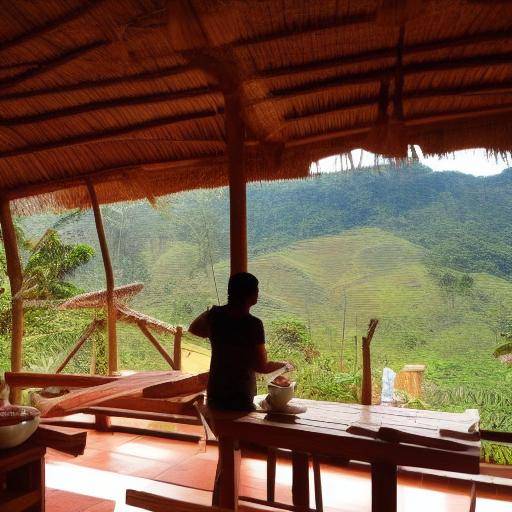
Colombian coffee has been internationally recognized for its exquisite taste and high quality. However, beyond the drink itself, there is a rich history and architectural legacy that reflects the influence of coffee on Colombian culture and society. In this article, we will explore the intersection between Colombian coffee, rural architecture and the history of coffee, discovering the typical houses and haciendas that make up the coffee route in Colombia.
The Coffee Route: A Journey Through Time and Architecture
The Coffee Route in Colombia is much more than a tourist destination; it is a journey through the history, aroma and taste of one of the most appreciated drinks in the world. Along this route, you can see the distinctive typical houses and haciendas that have witnessed the splendor and coffee tradition in the country.
The Colombian Café: Origen and Impact in Rural Architecture
Colombian coffee has deep roots that intertwine with the history of the country. From its humble beginnings in the fertile lands of the Andes mountain range, to becoming one of the main pillars of the Colombian economy, coffee has left an imprint on the rural architecture of the region.
Rural Architecture: El Encanto de las Casas Típicas y Haciendas Cafeteras
Typical houses and coffee farms are fundamental pieces in the puzzle of Colombian rural architecture. With its wooden architecture, red tiles and large galleries, these buildings reflect life and work in coffee plantations over the years.
History of the Café: Stories, Legends and Transformations
Dive into the exciting history of Colombian coffee, from its first crops to its global expansion. Discover the legends surrounding his discovery, its impact on the national economy and its influence on the architecture of the coffee region.
The Colombian Café Today: Innovation and Tradition in Harmony
Colombian coffee has evolved over time, combining centuries-old tradition with modern innovation. In rural architecture, this balance is reflected in the new techniques of cultivation and processing, which coexist with the old buildings that keep the coffee heritage alive.
The Coffee Route in Colombia: A Treasure for Discovering
By embarking on the Coffee Route in Colombia, visitors are transported to a world where coffee, architecture and history are intertwined to create a unique experience. It is a journey that allows us to appreciate not only the beauty of typical houses and haciendas, but also the soul of a region marked by coffee.
Conclusion
The coffee architecture in Colombia is a tangible reflection of the rich history and impact of coffee on society. From typical houses to the majestic haciendas, every architectural detail tells a history of hard work, tradition and passion for Colombian coffee. As you tour the Café Route, you discover a world of aromas, flavors and architectural beauty that captivates visitors and gives them the opportunity to immerse themselves in the fascinating history of Colombian coffee.
Frequently asked questions
What is the cultural importance of Colombian coffee in rural architecture?
The cultural importance of Colombian coffee in rural architecture lies in its ability to narrate the history of the coffee-growing communities, reflecting the values, traditions and hard work that has marked the lives of generations.
How has the architecture of coffee farms evolved over time?
The architecture of the coffee farms has evolved to adapt to new techniques of coffee cultivation and processing, as well as to the changing needs of the families that inhabit them. Although they have preserved their traditional charm, many haciendas have incorporated modern amenities without losing their historical essence.
What is the impact of coffee on the Colombian economy and its reflection on architecture?
Coffee has been a fundamental pillar of the Colombian economy, and its impact is reflected in the architecture through the prosperity it brought with it. Coffee farms are testimony to the wealth generated by coffee, which is reflected in the majesty and elegance of these buildings.
How has the history of coffee influenced the rural architecture of Colombia?
The history of coffee has left a deep mark on the rural architecture of Colombia, influencing the design and distribution of typical houses and haciendas. This legacy is perceived in the structure, materials and decoration of these buildings, which have been shaped by the coffee culture.
What measures are being taken to preserve and promote the coffee architecture in Colombia?
Programs are being implemented for the preservation and promotion of coffee architecture in Colombia, which include the restoration of historical buildings, the creation of tourist routes and the diffusion of the cultural importance of these buildings.
What is the role of coffee architecture in the cultural identity of Colombia?
The coffee architecture is a fundamental part of Colombia's cultural identity, as it represents the history, traditions and hard work of the coffee communities. These constructions are symbols of pride and root to the roots of the country.
How is the architecture of coffee farms related to environmental sustainability?
The architecture of the coffee farms has shown an intrinsic relationship with environmental sustainability, as many of these buildings have been designed to integrate harmoniously with the natural environment and respect the natural resources, contributing to the conservation of the ecosystem.
This article we hope has managed to transport the readers to the fascinating journey of the Coffee Route in Colombia, and that they have enjoyed discovering the typical houses and haciendas that are testimony to the cultural and historical wealth surrounding Colombian coffee.

